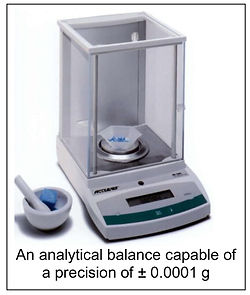mass
'no magic to the mole'
amount
molar mass
concentration
solution volume
gas volume
molar gas volume
Avogadro
constant, L
number of
entities, N
Now try the following question.
F7. MASS OF SOLUTE FROM CONCENTRATION & VOLUME, m = c V M
While the mole is the S.I. unit for amount of substance which chemists normally prefer,
there are no routine devices that directly measure this physical quantity, i.e., in ‘moles’. For this reason an amount of substance is usually calculated from other easily measured quantities such as mass or volume.


So, frequently in the laboratory we measure masses of substances using a top-pan balance in order to calculate chemical amounts and concentrations.
Questions met on examination papers tend to mirror this approach.
It is not possible to select a reagent bottle from the laboratory shelf and then routinely measure out directly an amount of substance, e.g., n(B) = 0.500 mol
Logically, therefore, the types of problem met so far must be extended to involve calculating the mass of solute required to prepare a given volume of solution of known concentration.
Since it is not possible to measure amount of substance directly, in a typical laboratory it is the mass which will be determined instead. Problems, therefore, frequently require an extra stage as the mass of a substance is given, not the amount. It is a straightforward procedure to obtain the amount
using
n =
M
m
i.e., dividing mass by molar mass. This relationship is used in conjunction
with
c =
V
n
Of course, calculating molar masses from Ar data requires care in itself.
This section continues by considering a worked example.

Note that the final answer has been expressed to three significant figures (3 s.f.). When multiplying or dividing measured physical quantities, as a rule of thumb, the precision of a quoted answer is generally dictated by the least precise item(s) used – in this case both the concentration and the volume provided by the question are quoted to just 3 s.f.



